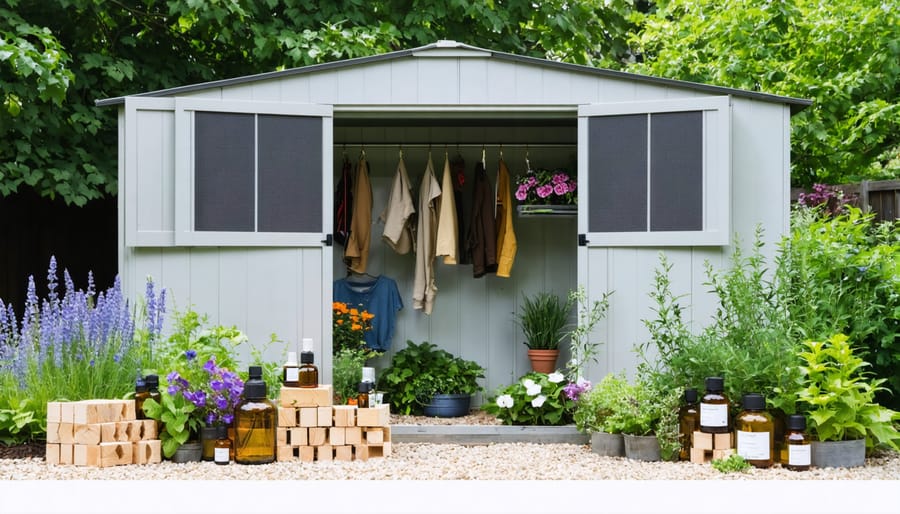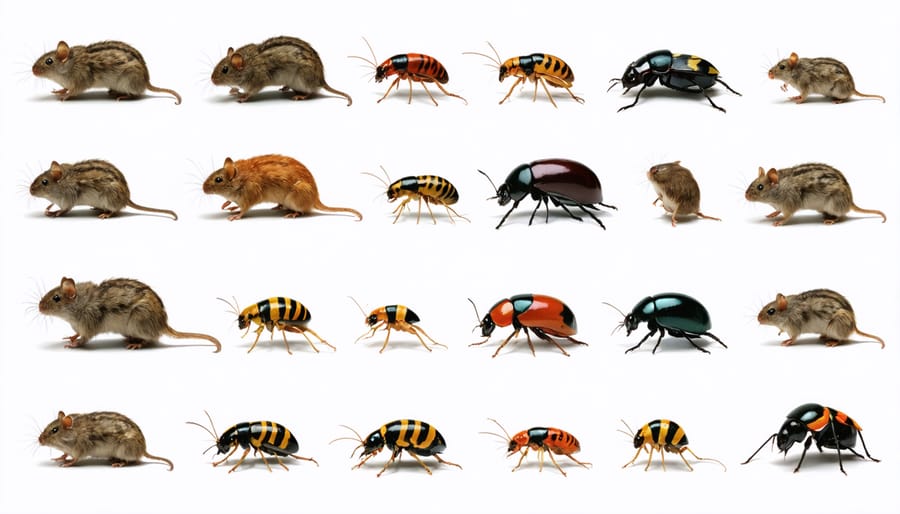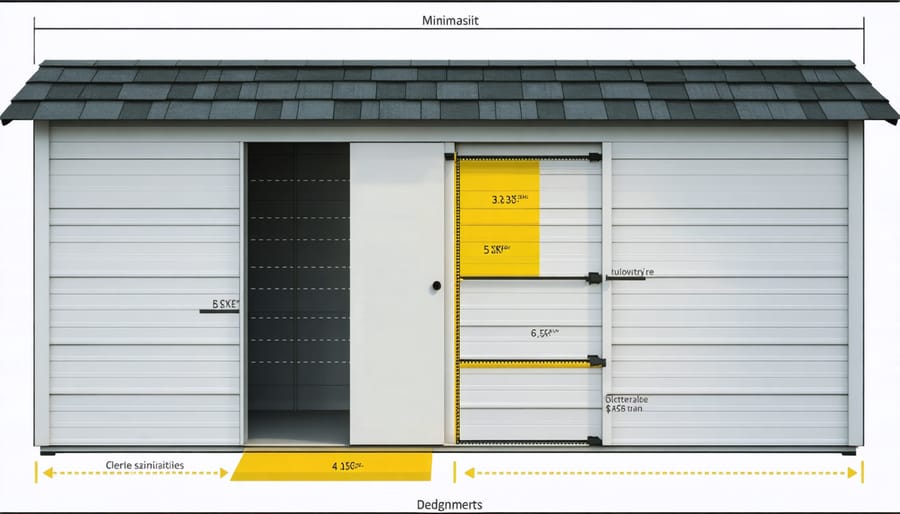Smart Storage That Fights Back: Keep Pests Out of Your Shed for Good

Implement comprehensive storage space pest control through strategic layering of preventive measures. Seal entry points with weather stripping and mesh screens, blocking even the smallest gaps where pests commonly infiltrate. Monitor pest activity using sticky traps and moisture meters to identify problem areas before infestations take hold. Create natural barriers by maintaining a 2-foot vegetation-free zone around storage structures and using cedar blocks or essential oils as deterrents.
Rather than relying on reactive chemical treatments, integrated pest management focuses on long-term prevention through environmental modification. This approach combines structural improvements, natural repellents, and regular monitoring to protect stored items while minimizing chemical exposure. By addressing the root causes of pest problems – moisture, food sources, and entry points – homeowners can maintain pest-free storage spaces without compromising safety or effectiveness.
Let’s explore how these proven strategies work together to create a sustainable pest management system that protects your valuable belongings year-round.
Understanding Your Storage Enemy
Common Storage Invaders
Storage spaces often attract a variety of unwanted guests that can damage your belongings. The most common invaders include mice and rats, which are experts at preventing rodent infestations requires vigilant monitoring. Other frequent visitors include silverfish, which are drawn to paper and fabric items, and moths that can wreak havoc on stored clothing and textiles. Carpenter ants and termites pose serious threats to wooden structures and stored materials, while cockroaches can infiltrate even the smallest openings. Beetles, particularly the powder post variety, may target wooden furniture and structural elements. Spider infestations, while less damaging to belongings, can create unsightly webs and cause discomfort for storage space users. Understanding these common invaders is the first step in developing an effective pest management strategy for your storage area.

Pest Entry Points
Pests are resourceful creatures that can find their way into storage spaces through surprisingly small openings. Common entry points include gaps around doors and windows, cracks in foundations, holes around utility lines, and damaged vents or screens. Even a quarter-inch opening can be enough for mice to squeeze through, while insects need much less space. The corners and edges of storage structures are particularly vulnerable, especially where different materials meet or where weather stripping has deteriorated.
Roof lines and eaves often provide hidden access points, particularly when leaves and debris accumulate. Tree branches touching your storage structure can create natural bridges for pests, while ground-level entry points may develop where flooring meets the foundation. Areas where pipes, electrical lines, or other utilities enter the structure are also common weak points that pests exploit. Regular inspection of these potential entry points is crucial for maintaining an effective pest barrier around your storage space.

Building Your Pest Defense System
Smart Material Choices
Choosing the right materials for your storage solutions plays a crucial role in keeping pests at bay. Start with naturally pest-resistant woods like cedar, which contains oils that repel many insects, including moths and beetles. For shelving and storage containers, opt for heavy-duty plastic or metal options with tight-fitting lids that create an impenetrable barrier against unwanted visitors.
When selecting storage bins, look for those made from high-density polyethylene (HDPE) or polypropylene, as these materials are not only durable but also resist gnawing from rodents. Clear containers are particularly useful as they allow you to spot any pest activity without opening them.
Consider using wire mesh or hardware cloth for ventilation areas, ensuring the holes are no larger than ¼ inch to prevent mice and rats from entering. For fabric storage, vacuum-sealed bags made from thick, puncture-resistant materials offer excellent protection against moths and other fabric-loving pests.
Weather stripping and door sweeps should be made from durable materials like rubber or silicone, which maintain their shape and seal even with frequent use. When installing wooden elements, choose pressure-treated lumber for ground contact areas to prevent termite infestation and decay.
Remember to regularly inspect these materials for signs of wear and tear, as even the most pest-resistant options need occasional replacement to maintain their effectiveness.
Structural Solutions
Building a pest-resistant storage space starts with smart structural design choices. The key is creating physical barriers that naturally deter pests while maintaining the functionality of your storage area. Start by ensuring all foundation gaps are properly sealed with weather-resistant materials like concrete or metal flashing. Install metal or vinyl door sweeps at the bottom of all entrances, and use fine mesh screens on any vents or openings.
Pay special attention to proper shed ventilation while preventing pest entry. Use hardware cloth with openings no larger than 1/4 inch for ventilation covers, which allows airflow while blocking even small rodents. Consider installing sloped metal flashing around the base of your storage structure, making it difficult for pests to climb up and find entry points.
Weather stripping around doors and windows creates an effective seal while still allowing easy access to your storage space. For additional protection, install door closers to ensure entries aren’t accidentally left open. Caulk all visible gaps and cracks, paying particular attention to areas where utilities enter the structure.
Remember to regularly inspect these structural elements for wear and tear, as even small damages can create new entry points for pests. Maintaining these physical barriers is far more cost-effective than dealing with an infestation later.
Natural Deterrents
Nature provides many effective and non-toxic solutions for pest control that can protect your storage space while keeping your family and environment safe. One of the most versatile natural deterrents is diatomaceous earth, a powder made from fossilized algae that’s harmless to humans but effectively controls crawling insects by damaging their exoskeletons.
Essential oils aren’t just for making your space smell nice – they’re powerful pest deterrents too. Peppermint, citrus, and eucalyptus oils naturally repel various insects and rodents. Simply add a few drops to cotton balls and place them strategically around your storage area, refreshing them every few weeks.
Cedar is another time-tested natural solution. Cedar blocks, chips, or boards not only add a pleasant aroma but also naturally repel moths and other fabric-damaging insects. Consider installing cedar panels or placing cedar sachets in areas where you store clothing and textiles.
Herbs like lavender, rosemary, and bay leaves can be dried and bundled to create natural pest-repelling sachets. These not only help keep unwanted visitors away but also add a pleasant natural fragrance to your storage space.
For outdoor storage areas, companion planting with pest-repelling plants like marigolds, chrysanthemums, and mint creates a natural barrier while adding beauty to your landscape. These plants naturally deter many common garden pests and can help protect your storage area from unwanted invasions.

Maintenance for Long-Term Protection
Regular Inspection Schedule
Establishing a consistent inspection routine is crucial for effective pest management in your storage spaces. As part of your regular shed maintenance, create a monthly checklist that covers all potential entry points and problem areas.
Start by examining the exterior perimeter of your storage space, looking for gaps, cracks, or holes that could serve as entry points. Pay special attention to areas where utilities enter the structure and inspect weather stripping around doors and windows. Inside, focus on dark corners, areas behind stored items, and spaces near food storage (if applicable).
Schedule these thorough inspections for the first weekend of each month to maintain consistency. During spring and fall, increase the frequency to bi-weekly checks, as these seasons often see increased pest activity. Keep a simple logbook to track your findings, noting any signs of pest activity, moisture issues, or structural concerns that need addressing.
Remember to inspect stored items as well, particularly cardboard boxes or fabric materials that might attract pests. Using a flashlight, examine the undersides of shelves and corners where spider webs or droppings might accumulate. This proactive approach helps identify potential issues before they become serious problems, saving you time and money in the long run.
Quick Response Strategies
When you spot signs of pest activity, quick action can prevent a small problem from becoming a major infestation. Start by thoroughly inspecting the affected area to identify the type of pest and extent of the problem. For rodents, set appropriate traps in high-activity areas and seal obvious entry points immediately using steel wool or metal flashing. If you notice insects, vacuum the affected area thoroughly and dispose of the bag outside your property.
Create temporary barriers using food-grade diatomaceous earth around entry points and affected zones – this natural solution is safe for households while effectively deterring many crawling insects. For flying pests, install sticky traps to quickly reduce their numbers while you develop a longer-term strategy.
Document all signs of pest activity, including dates and locations, to help track the effectiveness of your response and identify patterns. Take photos if possible, as these can help pest control professionals provide more targeted solutions if needed.
Remember that quick responses should focus on containment rather than just elimination. While addressing the immediate threat, begin implementing preventive measures like improved storage practices and regular cleaning routines. This two-pronged approach ensures you’re not just solving today’s problem but preventing tomorrow’s as well.
Implementing an effective integrated pest management strategy is not just about solving current problems – it’s about creating a sustainable, long-term approach to protecting your storage space and valuable belongings. By combining prevention, monitoring, and targeted interventions, you can maintain a pest-free environment while minimizing the use of harsh chemicals and reducing long-term costs.
Remember that successful pest management starts with proper building maintenance and regular inspections. Small steps like sealing entry points, maintaining proper ventilation, and keeping surrounding areas clean can prevent major infestations before they begin. The combination of physical barriers, natural deterrents, and smart storage practices creates multiple layers of protection for your belongings.
When issues do arise, having a planned response strategy allows you to act quickly and effectively. By understanding common pest patterns and implementing appropriate solutions, you can address problems at their source rather than just treating symptoms. This proactive approach not only protects your stored items but also maintains the structural integrity of your storage space.
Most importantly, integrated pest management is an ongoing process that requires consistency and attention. Regular maintenance checks, updating prevention methods as needed, and staying informed about new pest control solutions will help ensure long-term success. With these practices in place, you can enjoy peace of mind knowing your storage space remains protected and your belongings stay safe.

